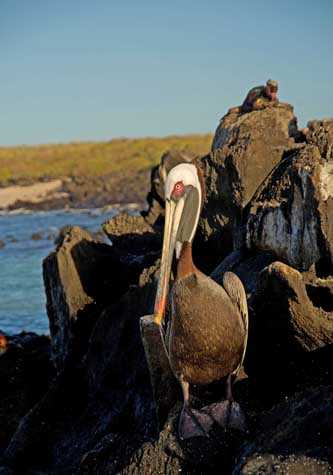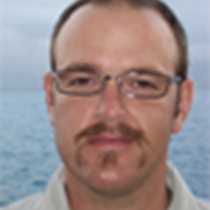Settling into the concept that we are accepted as a part of this environment among these incredible creatures, we explored the island of Espanola. Our early morning kayakers paddled along the coast at Gardner Bay, encountering Pacific green sea turtles occasionally bringing their heads above the surface for a breath of air. Large opuntia prickly pear cacti appeared to be growing from the basalt cliffs that loomed above us. Darwin finches flitted around the sparse vegetation as they searched for sustenance for themselves and their chicks.
As we returned to our floating home we found the sun starting to break through the cloud cover, brightening our day. Then we explored the undersea world from the coast and from our Zodiacs. We saw an octopus trying to escape from a very brave damselfish protecting its algae garden. A spiny lobster ventured onto the seafloor, dipping in and out of the boulder terrain searching for the catch of the day. Large schools of razor surgeonfish draped the shallow reef, feeding en masse.
As we finished our snorkel, we encountered an energetic group of young sea lion curious about these strange creatures with peculiar fins. They nibbled on our flippers and decided that we were nice enough to play with. Our beach explorers encountered a more relaxed group of sea lions resting on the beach after their foraging run. Meanwhile, a Galapagos hawk presided over the beach from its perch on a national park sign.
After returning to our ship, a short navigation over turquoise waters brought us to Suarez Point on the western coast of Española island. This drab low-lying island did not appear at first to hold much interest for us explorers. However, when we landed we were completely surprised by the wildlife on this boulder-filled coastline. Marine iguanas lazed among the rocks, noticeable for the bit of red coloration along their backs. Española mockingbirds fought for territory with a display of wing beats and tail feather-bobbing.
As we moved along the southern cliffs, red-billed tropic birds screeched overhead as Nazca boobies vied for space along the edge of the higher precipices. Water vapor floated in the air from pounding waves that became compressed in old lava flows. With the sun dipping into the horizon, a waved albatross landed in the center of the breeding colony. This species is endemic only to this island in the Galapagos, where they have returned to seek lifelong mates. As we watched, males and females began performing a peculiar mating display, which included head bobbing, neck swaying, beak clacking, and sky pointing.
Darkness started to blanket this archipelago as a contented group returned to our floating home, the National Geographic Islander.







